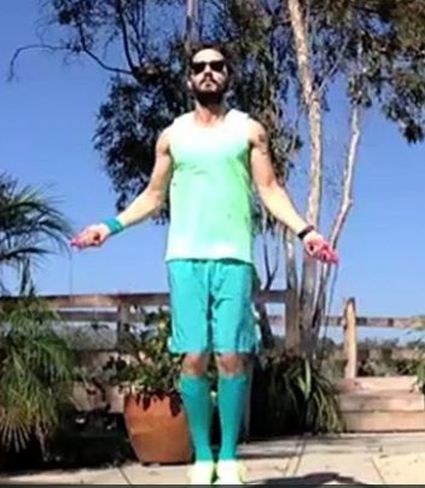
Metamodernist Genius: LaBeouf, Rönkkö & Turner
By Andrew J. Corsa, Ph.D.
In the first half of this webpage, I focus on the artistic collaboration between Shia LaBeouf, Nastja Säde Rönkkö, and Luke Turner. My webpage does not give a fully-fleshed, detailed account of their collaborative enterprise. Rather, it focuses on their work with a narrow purpose in mind. It reflects on their collaboration with the sole purpose of exploring how notions of genius operate within metamodernism. In particular, it explores how the collaborators' projects titled #STOPCREATING and #STARTCREATING relate to their broad metamodernist endeavor.
The second half of this webpage provides a more general account of the notion of genius in metamodernism. It builds on its earlier, more specific discussion of the LaBeouf, Rönkkö & Turner collaboration, in order to make broader claims about the notion of genius, and how it relates to metamodernism.
At various points, my project cites the excellent, scholarly work of Marjorie Perloff, Kenneth Goldsmith, Timotheus Vermeulen and Robin van den Akker, as well as others. But my project, itself, is NOT MEANT TO BE PARTICULARLY ACADEMIC. Its stylistic standards and commitment to rigor are very different from those of traditional academia. That said, let's begin:

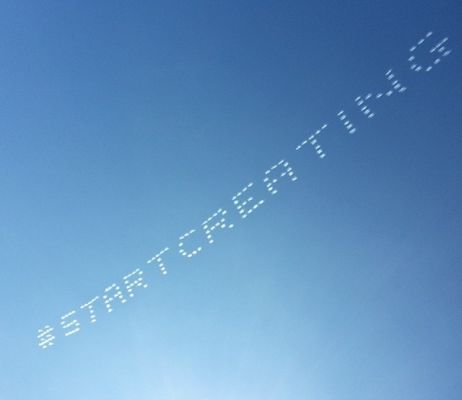
Collaborators LaBeouf, Rönkkö & Turner arranged for skywriters to spell out the phrase #STOPCREATING over Los Angeles on January 10th 2014 (see here). It has been reported that the phrase stretched five miles across the sky, and required five planes, working together, each emitting puffs of smoke to spell out the letters (see here). On the same day, collaborator Shia LaBeouf, who is well known for his staring roles in several Blockbuster action films, announced, on Twitter, his retirement from all public life.
In December of that year, prior to the skywriting, LaBeouf was accused of plagiarism. According to the press, when LaBeouf directed his short film HowardCantour.com, he "borrowed" substantial content from Daniel Clowes' comic Justin M Damiano without either asking permission or giving credit. LaBeouf has suggested that skywriting #STOPCREATING was an artistic response to a letter he received from Daniel Clowes' lawyer which, LaBeouf claims, insisted that "he must cease all efforts to create" (here). In fact, as part of the creative collaboration, LaBeouf, Rönkkö & Turner also arranged to skywrite the message, "I am sorry Daniel Clowes," in the air as well. During the months after the plagiarism accusations, the three collaborators undertook a number of endeavors, including their incredible performance art piece, #IAMSORRY which took place at the Cohen Gallery in Los Angeles (here). At this event, spectators were allowed, one at a time, to enter a room where LaBeouf sat, quietly, and there were no clear rules about what spectators could or couldn't do when they entered the room (here). When many of the spectators entered the room, they saw LaBeouf wearing a bag over his head with the phrase "I AM NOT FAMOUS ANYMORE" written on it. Later in the event, LaBeouf stopped wearing the bag. Sometimes, when spectators entered the room, they would see that LaBeouf was crying. The title of the piece, #IAMSORRY, presumably refers - at least to some degree, even if it picks up on other themes, as well - to the way LaBeouf felt in response to accusations of plagiarism. LaBeouf has remarked that, while he was sitting in the room: "i was genuinely remorseful - and full of shame and guilt / i was broken - it wasn't manipulation - i was heartbroken" (here). But then, a single day after #IAMSORRY ended in February (February 17th), the collaborators arranged for skywriters to place a new message in the air above LA: #STARTCREATING (here). They were now saying the exact opposite of what they had said only a month or two before.
What then, is the relation between #STOPCREATING and #STARTCREATING? How do these notions figure into the LaBeouf, Rönkkö & Turner collaboration, more broadly? And, most important for this webpage, how can reflecting on these notions help us to better understand the role of the notion of genius in metamodernism?
Part I
#StopCreating or #StartCreating
In this section, I will try to better understand the #STOPCREATING and #STARTCREATING projects by relating them to the work and thought of Kenneth Goldsmith.
On January 20th, 2014 - ten days after #STOPCREATING was written in the sky - an essay titled "#stopcreating," attributed to LaBeouf, was posted on The New Inquiry (here). The article is simply a collection of excerpts, written by Kenneth Goldsmith, from his book Uncreative Writing: Managing Language in the Digital Age. LaBeouf was not the original author of the article at all. At the top of the article is a photo of the #STOPCREATING message that LaBeouf, Rönkkö & Turner had arranged for planes to skywrite ten days before.
Luke Turner has denied that he and his collaborators had anything to do with creating the article for The New Inquiry, and Kenneth Goldsmith has suggested that he wasn't involved with the article, either. Nonetheless, the article draws a fascinating connection between the collaborators' #STOPCREATING project and the ideas expressed in Goldsmith's book. Months later, LaBeouf implied that he and his collaborators had, in fact, perceived a connection between Goldsmith's ideas and the #STOPCREATING project. LaBeouf wrote that #STOPCREATING was "tied in with Goldsmith's uncreative writing mantra" (here). Similarly, on Twitter, Goldsmith has tweeted: "Earlier this year I encouraged Shia LaBeouf to declare his retirement from public life and #stopcreating. It's true." And in response to this tweet, Turner replied: "Earlier this year Shia LaBeouf encouraged Kenneth Goldsmith @kg_ubu to embrace the future and #startcreating. It's true" (see: here). These tweets and remarks imply that there is a connection between Goldsmith's ideology and #STOPCREATING, and they imply that #STARTCREATING can be seen - at least to some degree - as a response to Goldsmith.
I have come to think of Goldsmith as a figurehead for all of the ideas and feelings captured by #STOPCREATING. I take it that LaBeouf, Rönkkö & Turner did not intend for Goldsmith to play this role as a figurehead. Instead, their work builds on and responds to postmodern ideas that have belonged to artists and theorists over the past 50+ years. Nonetheless, there are connections between Goldsmith's ideology and #STOPCREATING, which the collaborators have acknowledged, and I strongly believe that reflecting on these connections can help us to better understand not only the relations between #STOPCREATING and #STARTCREATING but also the role of the notion of genius in metamodernism.
In his book Uncreative Writing, Goldsmith writes: "For the past several years, I've taught a class at the University of Pennsylvania called 'Uncreative Writing.' In it, students are penalized for showing any shred of originality and creativity. Instead, they are rewarded for plagiarism, identity theft, repurposing papers, patch-writing, sampling, plundering, and stealing" (Goldsmith, p. 8; also see: http://thenewinquiry.com/features/stopcreating/).
I contend that the notion of #STOPCREATING is directly attached to the processes of plagiarism, sampling, patch-writing, etc. It is directly related to the kind of process LaBeouf undertook when he "borrowed" from Daniel Clowes, without giving credit, when he directed his short film HowardCantour.com.
I claim that the idea of #STOPCREATING ties directly to the notion of so-called unoriginal genius which Goldsmith lauds in his book. He borrows the notion and term from Marjorie Perloff, who wrote the book: Unoriginal Genius: Poetry by Other Means in the New Century. In order to understand this notion of unoriginal genius, and how it relates to LaBeouf, Rönkkö & Turner's notion of #STOPCREATING, this project will focus, first and briefly, on Perloff's discussions of unoriginal genius, and then turn more specifically to Goldsmith's unique treatment of the notion.
Perloff notes that, according to other authors including Frederic Jameson, in a postmodern ethos, the concept of "genius" is irrelevant and genius theory is "simply passé" (Perloff, 19). But Perloff, herself, chooses not to discard the notion of genius entirely, but rather to advocate for a new kind of genius, unoriginal genius rather than original genius. She writes that: "If . . . new 'conceptual' poetry makes no claim to originality - at least not originality in the usual sense - this is not to say that genius isn't in play. It just takes different forms" (Perloff, p. 21).
What exactly is unoriginal genius? To get at this, let us reflect on Kenneth Goldsmith's projects, which Perloff implies are examples of unoriginal genius at work. She focuses in particular on Goldsmith's 2007 book, Traffic, in which he "records a twenty-four-hour period of WINS's 'Panasonic Jam Cam [Camera]' New York traffic reports at ten-minute intervals on the first day of a holiday weekend" (Perloff, p. 147). All Goldsmith does in his book is transcribe traffic reports.
But is that all he does? Perloff notes just how strange the book Traffic really is. For example, in the first sentence of the book, we learn that the traffic reports are taking place on a holiday weekend, but, as Perloff points out, it is impossible for us to tell just which holiday (Perloff, p. 152). It strongly appears that Goldsmith has made a significant, artistic choice - omitting every detail that would let us know which holiday it is. Further, as Perloff points out, although the traffic reports all take place in contemporary New York City, the photo Goldsmith chooses - another significant artistic choice - for the book's cover does not appear to come from New York City at all. The source photo from which it is drawn shows foreign license plates and buses (Perloff, p. 152). The photo doesn't even seem to be from the right decade. It likely depicts the 1970s rather than any more recent decade (Perloff, p. 153).
Goldsmith, himself, notes that, while he calls what he does "Uncreative Writing," it in fact involves quite a bit of creativity (Goldsmith, p. 120). His appropriative projects involve hundreds of editorial decisions. What should he choose to appropriate or re-type (Goldsmith, p. 202) and what ought he choose to omit? Should he select passages and pictures from a wide variety of sources, or from a variety of times, and how should he synthesize the "found material into a cohesive whole" (Goldsmith, p. 113)? What font should he borrow, how should he arrange it (Goldsmith, p. 3), how should the project be formatted, and, finally, on what kind of paper stock should it be printed (Goldsmith, p. 118-119)?
As Goldsmith notes, unoriginal genius directly relates to what Perloff has called "moving information" (Goldsmith, p. 1). For a writer, it involves "pushing language around" (Goldsmith, p. 1). For visual artists, it presumably involves cutting up and re-arranging images, tropes, and ideas. Overall, it involves re-organizing a world of art and words that already exists. You select a set of sentences, ideas, and images that already exists in the world, and choose what to include and what to omit. I do NOT mean to demean this process; it is wildly more complex than I am making it sound, involving many thousands of creative choices. But I do suggest that this process involves taking that which already exists, and working to re-arrange and cut away from it. Distinguishing between "new re-arrangements" and "new content," we can say that Goldsmith rejects the latter. He claims: "The world is full of texts . . . I do not wish to add any more" (Goldsmith, p. 1).
Classically, the original genius which Goldsmith rejects has been described as an organic process. For example, the author and theorist Edward Young writes that: "An Original may be said to be a vegetable nature; it rises spontaneously from the vital root of genius; it grows, it is not made" (Young, p. 7) (1). An original genius, "out of a barren waste calls a blooming spring" (Young, p. 7), and an original genius "is a fertile and pleasant field," whose works are "fairest flowers" (Young, p. 6). In contrast, Goldsmith describes the process of unoriginal genius as mechanical. He compares his process to what Andy Warhol called "mechanical art" (Goldsmith, p. 140), he suggests that today's writers resemble programmers (Goldsmith, p. 1), and he compares the unoriginal genius's manipulation of language and images with machine-created art (Goldsmith, p. 15).
Goldsmith's description of his own process sounds similar to Young's much older description of what he calls "Imitations." In contrast to works of original genius, which are organic and natural: "Imitations are often a sort of manufacture wrought up by those mechanics, art, and labour, out of pre-existing materials not their own" (Young, p. 7). Anyone who can truly be called an "author" cannot borrow too much from outside sources, use common tools (Young, p. 13), or limit his creativity to picking between pre-existing choices. Goldsmith himself wittily suggests (tongue-in-cheek?) that when people ask what he does, he does not call himself a writer, but instead: "I simply refer to myself as a word processor" (here).
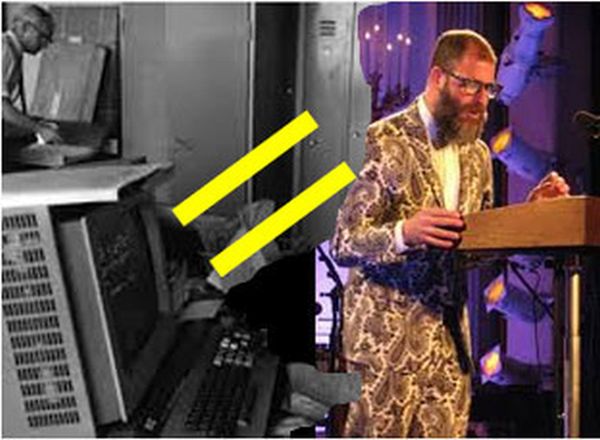
The LaBeouf, Rönkkö & Turner #STOPCREATING project is directly tied to Goldsmith's notion of unoriginal genius. Keeping this in mind, what does it mean that, a day after #IAMSORRY commences, LaBeouf, Rönkkö & Turner skywrite #STARTCREATING instead?
I take them to suggest that Goldsmith's unoriginal genius is not sufficient, on its own. Goldsmith pursues only unoriginal genius - only #STOPCREATING - but it looks like something else is needed either instead, or in addition. We must also commit to #STARTCREATING. Unoriginal genius must either fall short, or, at least, not be the end-all-and-be-all-in-itself. It is worth noting that, as of March 9th, 2015, there is no reference to the #STOPCREATING project on the collaborators' central webpage, thecampaignbook.com, but there is an entire page dedicated to images associated with #STARTCREATING.
LaBeouf is clear he thinks Goldsmith's approach falls short. He discusses this explicitly, in a project called #interview, which I have cited several times, above. As another part of his artistic collaboration with Rönkkö and Turner, LaBeouf participated in an intimate, email correspondence with Aimee Cliff, which the collaborators posted online, together with a video of an hour-long "interview" the two had in-person, in which neither spoke a single word (here).
It isn't clear to what extent the text of the interview was re-arranged or doctored for artistic reasons. Midway through the email interview, LaBeouf even makes a remark about the interview, itself:
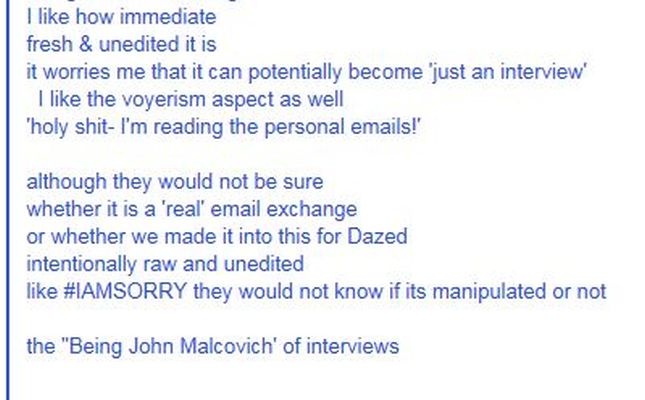
But, regardless of whether the interview was doctored or not, it clearly suggests that Goldsmith's process falls short, and I take it that LaBeouf would say that unoriginal genius is not the only kind which he desires:
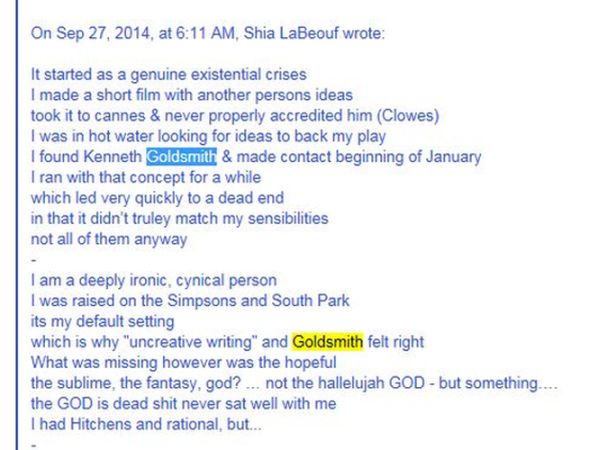
(My emphases on "Goldsmith")
LaBeouf feels that something is missing from Goldsmith's approach, which LaBeouf calls: "the hopeful / the sublime, the fantasy, god?" I think this would be a common feeling, among metamodernist artists. Something is missing, and what is missing, I will later argue, is an original genius that is hopeful and utopian, in a way that Vermeulen and van den Akker suggest.
What is metamodernism? As Turner suggests, contemporary art and culture have moved "beyond the postmodern mode of the late 20th century" (here). What has taken its place as the cultural dominant? Arguably, the answer is metamodernism. Metamodernism is a new sensibility which can be traced out in the trends and tendencies of a number of contemporary artists (Vermeulen and van den Akker (B), p. 2). Theorists who discuss metamodernism, and the artists they discuss, have held numerous gallery shows and global symposiums.
Metamodernist artists still embrace some postmodern tendencies. But, as Turner suggests, they do even more. Yes, they engage with postmodern "deconstruction, irony, pastiche, relativism, [and] nihilism" (here). But they also engage with modern "sincerity, hope, romanticism, affect, and the potential for grand narratives" (Turner). Metamodernist artists oscillate between "a modern enthusiasm and a postmodern irony" (Vermeulen and van den Akker (A), pp. 5-6). We can be both ironic and sincere without diminishing either our irony or sincerity (Turner). We can embrace a contemporary attitude of "informed naivety" (Vermeulen and van den Akker (A), p. 5), sincerely acting as if transcendence is possible, even if we feel it really isn't (Turner).
In later sections of this project, below, I will argue that metamodernist artists do not whole-sale reject the notion of unoriginal genius. In fact, I maintain that many of them are unoriginal geniuses. But rather, I contend that - at least unconsciously - many of them don't see this kind of genius as sufficient, on its own. Many pursue more hopeful, sublime, original genius, too. I will contend that they oscillate between original genius and unoriginal genius. I haven't defended this contention, yet. Before I can, I need to establish several points:
(A) I need to show that the artistic collaboration between LaBeouf, Rönkkö, and Turner should be viewed as directly relevant to metamodernism, overall, so that what it implies about genius can be seen in this broader context. (B) I must further explore what their collaboration suggests about genius, before relating these suggestions to metamodern theory more broadly.
To accomplish these ends, I will need to further explore the role of Shia LaBeouf in the LaBeouf, Rönkkö & Turner collaboration. He is clearly the public face of their collaboration. Further, I contend that their collaboration seeks to paint him as a metamodernist genius, himself. By reflecting on his role in the collaboration, and how the notions of genius relate to him, I will better be able to discuss metamodernism in general.
Before I can connect LaBeouf up to the notions of metamodernism and genius, I should first offer a brief description of LaBeouf, the man himself. My intention will be to give a "flavor" of him and his thought, rather than a complete biographical picture. I will focus on providing several descriptions, from a few isolated moments of his life, and describe what he thought about them. I will not provide a general summary.
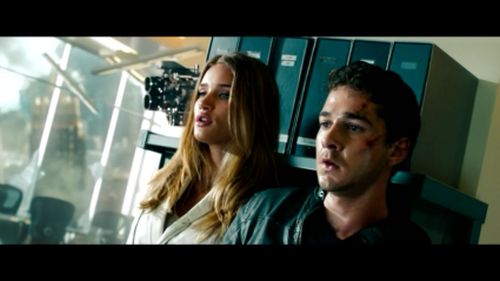
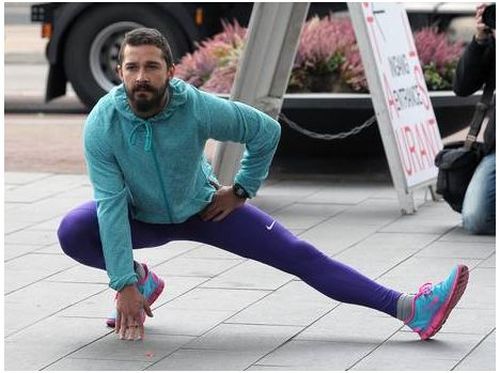
Introducing Shia LaBeouf
LaBeouf previously played the lead hero, Sam Witwicky, in the blockbuster Transformers film series. In the 2011 film, Transformers: Dark of the Moon, there is a moment in which Sam is standing next to his unbelievably, crazily beautiful girlfriend, Carly, played by Rose Huntington-Whitely. Despite the fact that they have just fought their way through a dozen action sequences, running away from terrible, transforming robots called Decepticons, Carly's hair is still perfect - her skin flawless and unharmed. Both are breathing heavily, their eyes unblinking, trying to remain still, trying to remain quiet. Their backs are up against a pillar, and he grasps her hand in his. Her pupils dart around periodically. His remain level, his eyes unblinking. A Decepticon's massive, CGI gun suddenly appears, poking out from behind the column. A Decepticon is looking for them. He hasn't found them yet. "Don't . . " LaBeouf pauses, breathing, " . . . move."
In 2014, a symposium on metamodernism was held at the Stedelijk Museum in Amsterdam titled "Metamodernism - The Return of History." Inside the museum, participants discussed the Metamodern state of mind, and, according to the symposium website, addressed question such as: "How does nationalism relate to Utopian desires?" and ""What effects did Web 2.0 have on narrative?" (here). While they were having these discussions, outside LaBeouf was running a so-called #metamarathon, running around the museum again and again, - 144 laps overall (here). He chose to wear tight purple leggings while he was running. And he warmed up for his run, first, trying to ignore reporters while he did. This, again, was part of LaBeouf's collaboration with Rönkkö and Turner.
During the #interview project, described above, LaBeouf refers to both Transformers (though not directly; I'm presuming) and also to the #metamarathon. About Transformers (I'm presuming), he writes:
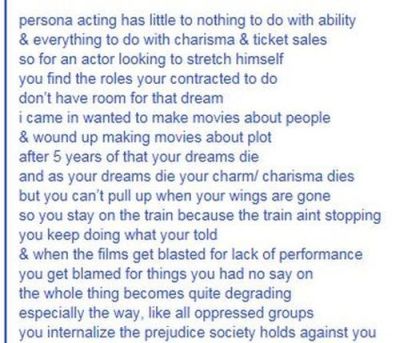
About the #metamarathon, he writes:
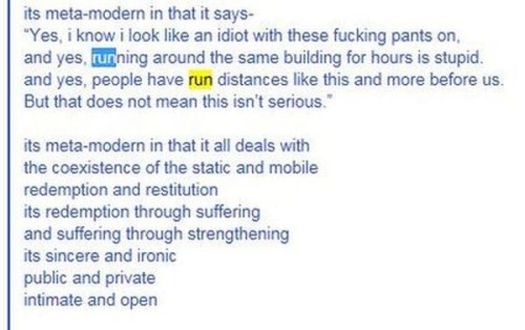
Why isn't it even stupid-er, to pretend that somehow your girlfriend doesn't have a scratch on her while a CGI robot is coming after you? I honestly don't see much of a difference, in terms of weirdness, between running around a museum in purple leggings - done as part of an awesome symposium on metamodernism - and pretending that you and your super-girlfriend are assisting CGI super-robots.
By the time I had heard of the #metamarathon, I had already seen two Transformers films. I had seen them as fun action films. But I hadn't yet seen the 2011 Transformers film. I only saw it after I had already read about and seen clips of the #metamarathon. And when I finally did see the film, I could no longer see it as just an action film. I couldn't help see it, instead, as a relative - a cousin - of the #metamarathon. We can reflect on what LaBeouf writes about the #metamarathon, above, but take it to be about the film, instead. I can imagine LaBeouf saying: "Yes, I know that the dialogue of this movie is idiotic, and that it is all just pretend, and that beyond that it's pretty ridiculous that my character Sam manages to survive all this craziness. But that doesn't mean this isn't serious."
Shia LaBeouf As Metamodernist Genius
The artistic collaboration between LaBeouf, Rönkkö & Turner has made LaBeouf appear as a great metamodernist thinker in his own right. For a time, Luke Turner's essay, "The Metamodern Manifesto" (here), was attributed to LaBeouf. It is as if collaborators were making LaBeouf into the originator of the ideas behind the manifesto, rather than Turner.
Further, LaBeouf gave performances, via Skype, for Timotheus Vermeulen's university classes. During them, LaBeouf gave dramatic readings both of "The Metamodernist Manifesto" and "Notes on Metamodernism," a piece written by Vermeulen and Robin van den Akker. In the youtube.com video of this performance, shared to the left, there are few indications that LaBeouf isn't the author of the words he is speaking. Rather, it is sometimes possible to forget that he is reading anything at all. It often sounds as if he is making up words on the spot. Even if the dramatic readings don't make LaBeouf seem like the original author of these pieces, they definitely suggest that he is a metamodernist artist himself, aligned with those who have helped to develop or at least describe the Metamodern structure of feeling.
Above, we saw that the LaBeouf, Rönkkö & Turner collaboration suggests that #STOPCREATING and unoriginal genius are insufficient on their own. LaBeouf has suggested that something important and hopeful is missing from Goldsmith's unoriginal project. Instead of just embracing unoriginal genius, we can also embrace original genius as well.
If we recognize that LaBeouf is meant to be seen as a/the quintessential metamodernist artist, can we now draw a more general conclusion? I contend that many metamodernist artists intend for their work to involve a more hopeful, original genius in addition to unoriginal genius.
In order to begin to defend my claim that many metamodernist geniuses oscillate between both original genius and unoriginal genius, I can appeal to the work of Vermeulen and van den Akker, who are influential in their ability to articulate the Metamodern sensibility.
First, Vermeulen and Robin van den Akker note that metamodernist artists apply methods and techniques that, while different from Goldsmith's, seem to be akin to those he pursues. They note, for example, that discussions of the artistic work of David Thorpe, for instance, often focus on his work's "eclectic reappropriation . . . or what one might call its multimediality or intertextuality" (Vermeulen and van den Akker (B), p. 4). They relate that Thorpe has a tendency to borrow ideas and conventions from other traditions. Considering his body of work overall, we can see that Thorpe appropriates: "motifs from mid-century science fiction, German Romanticism, nineteenth-century American landscape painting and traditional Japanese wood cuttings . . . new-age and sectarian iconography . . . religious imagery, pagan elements . . . IKEA and other DIY features . . . philosophical concepts or figures such as Nietzsche's Zaruthustra, Foucault's Panopticon, or the Messiah" (Vermeulen and van den Akker (B), p. 5). Thorpe's tactics seem right in keeping with those which Goldsmith describes. Many metamodernist artists embrace - or at least do not wholesale reject - the strategies of the unoriginal genius. Nor do they reject the techniques or tropes of Postmodernism. Both postmodernism and metamodernism appeal to irony, pluralism, and deconstruction (Vermeulen and van den Akker (A), p. 10).
But many metamodernist artists do not seem to find the unoriginal genius's strategies sufficient on their own. Many metamodernist artists, whose work Vermeulen and van den Akker explore, seem to be searching for something new - something which the strategies of the unoriginal genius, taken alone, could never give them. For instance, Thorpe "engages with fragments from past movements and genres precisely in order to discover a new filed hitherto uncharted, that is, as of yet unsignified possibilities" (Vermeulen and van den Akker (B), p. 5). Vermeulen and van den Akker also describe Ragnar Kjartansson's piece, The End, a performance piece from 2009 that lasted for six months, in which Kjartansson was locked in a lavish palazzo room with a close friend. Visitors could visit the room, and watch as, each day, Kjartansson painted a brand new painting of his friend, while the two drank beers and smoked cigarettes. Vermeulen and van den Akker relate that: "It was as if by inducing himself into a state of semi- or subconsciousness, by being together with him, and by painting him again and again, Kjartansson tried to find something about his friend that he had not discovered before, something unknown to him one day that might reveal itself the next" (Vermeulen and van den Akker (B), p. 7).
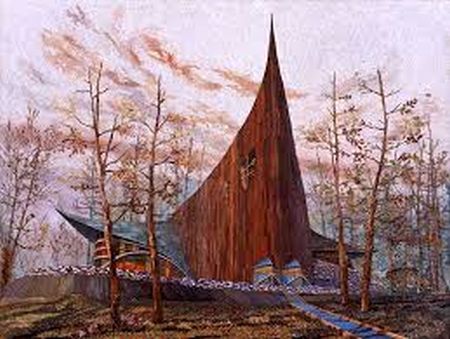
Many metamodernist artists seem to seek "the figure of utopia " (Vermeulen and van den Akker (B), p. 1), a figure previously associated with Modernism (Vermeulen and van den Akker (A), p. 4), which Postmodern techniques on their own cannot supply. Focusing on Thorpe, for instance, Vermeulen and van den Akker describe the "utopia that emerges" from his "eclectic reappropriation" in his mixed media collage, Good People (shown at right). They describe how, by appropriating a range of stylistic conventions and materials, he is able to recognize a strange, problematic utopic world (Vermeulen and van den Akker (B), p. 5). And they suggest that Kjartansson's work, too, reimagines utopia through its incorporation of both hope and irony (Vermeulen and van den Akker (B), p. 8).
Vermeulen's and van den Akker's keen insights seem to be consistent with - even if they don't obviously defend - a gut-level intuition that I possess and feel strongly. I feel that metamodernist artists cannot sincerely strive for something truly new, as they do - even if they were certain of their own failure - without embracing or pursuing original genius. As suggested above, all Goldsmith's unoriginal genius permits is the re-organization and re-formatting of a world that already exists. And we will never - and couldn't even naively hope to - arrive at anything truly new this way. I cannot help but feel that the "figure of utopia" which plays an important role in these artists work is paired with traditional, original genius, rather than with Goldsmith's unoriginal genius.
Thus far, I have provided little real evidence for this assertion, beyond citing my brute, gut-level intuition. But I have provided some: It is very clear that LaBeouf, whose artistic collaboration with Rönkkö and Turner casts him as a/the quintessential metamodernist artist, is himself unsatisfied with the unoriginal genius embodied by Goldsmith, and seeks something more. The LaBeouf, Rönkkö & Turner collaboration serves as an excellent example of a metamodernist artistic project that is unsatisfied with unoriginal genius on its own, and seeks to incorporate original genius, as well. It oscillates between #STOPCREATING and #STARTCREATING, between the unoriginal and the original.
I take LaBeouf, in his #interview, to make much the same point that I have above, just not as fully-fleshed:
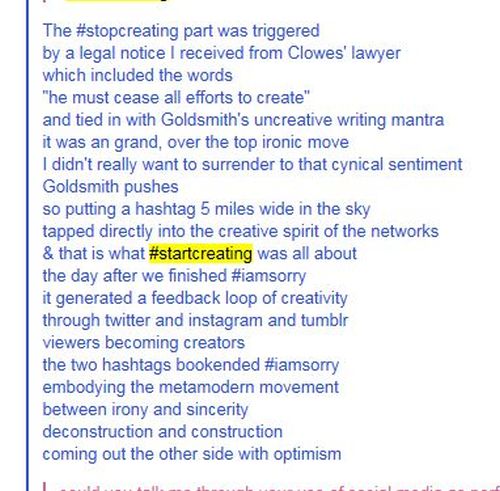
(My emphasis on #startcreating)
#STOPCREATING is aligned with Goldsmith's unoriginal genius. It is tied to irony and cynicism.
#STARTCREATING is aligned with the notion of original genius. It is tied to sincerity and optimism (utopia).
Vermeulen and van den Akker suggest that metamodernism "oscillates between a modern enthusiasm and a postmodern irony, between hope and melancholy, between naivete and knowingness, empathy and apathy, unity and plurality, totality and fragmentation, purity and ambiguity" (Vermeulen and van den Akker (A), pp. 5-6). LaBeouf seems to suggest that #STARTCREATING (original genius) and #STOPCREATING (unoriginal genius) are the two poles between which metamodernism oscillates, the first lining up with a modern sincerity, and the second lining up with a postmodern irony. It is the first, #STARTCREATING, which LaBeouf felt was missing from Goldsmith's work. That is what is aligned with what LaBeouf calls "the hopeful / the sublime, the fantasy, god" (here), and what Vermeulen and ven den Akker call "the figure of utopia."
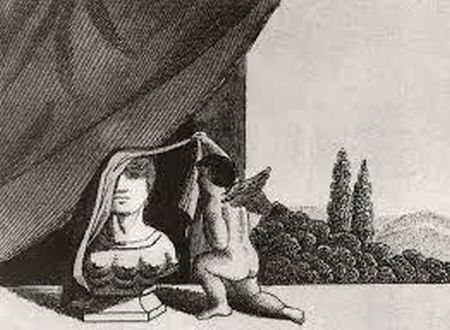
PART II
What Makes a Metamodernist Genius?
By the end of part II, I will seek to establish more firmly that it is characteristic of a many metamodernist artists - not just LaBeouf, Rönkkö & Turner - that they embrace original genius in addition to unoriginal genius. Before I can do so, I must first describe, in general terms, what many metamodernist geniuses seek to accomplish - what is characteristic of metamodernist genius. This will be the primary pursuit of the next several sections of this project.
The painting to the left is titled "Genius Unveiling a Bust of Nature." (I cannot find the name of the painter). Perhaps, we might think, this is what geniuses really do. They find truth that is hidden from the rest of us and share it with us, unveiling the world for our view. They look behind the world of appearances, and discover hidden truths.
I would NEVER suggest that artists never do this, or that metamodernist geniuses never do or can't. In fact, I'm inclined to think that they can. But, for now, I just want to draw attention to a different alternative for what a genius might do. I am going to focus on this alternative, because at least some theorists who write about metamodernism seem to think that this alternative is an important end for a number of metamodernist artists.
It is important for this project to fit with what other metamodernist theorists have tried to express. It is important, for this project, to express a point of view that feels right to them, and is, in an emotional sense, satisfying. Why is this an important goal?
Vermeulen and van den Akker describe metamodernism as a "structure of feeling" (Vermeulen and van den Akker (A), p. 2.), which is a sentiment or cultural sensibility of which many are aware, but which is difficult to pin down (Vermeulen and van den Akker (B), p. 2). They also describe metamodernism in relation to an "attitude" - one of "informed naivety" - that is tied to the current generation (Vermeulen and van den Akker (A), p. 5), and they relate it to certain "feelings" that generation experiences (Vermeulen and van den Akker (B), p. 4).
To the extent, then, that a new approach to metamodernism feels wrong, or does not satisfyingly fit within the hard-to-pin-down cultural sensibility, other theorists would have good reason to doubt its accuracy. No doubt, a new account of metamodernism need not be wrong just because it feels wrong. Perhaps other theorists might simply need to re-evaluate their sense of the cultural sensibility. But an account that feels wrong still remains doubtful. Here, I seek to provide an account that is faithful to the cultural sensibility to which other theorists have referred, and I hope it will seem fitting to them.
In 2012, Cher Potter of Tank Magazine interviewed Vermeulen (interview reproduce in full here), and asked him how the notion of genius operates within metamodernism. Vermeulen responded: "Goethe once said that genius is the ability to see what no one else can see even though it is open to everyone. If there would be such a category as the metamodernist genius, she or he would not be someone who is more talented than others, but rather someone who is able to put into words alternative relationships. But really, I would have to think about this matter some more."
The famous author, Goethe, did not think that a true genius actually unveils nature. Goethe wrote a number of quatrains focusing on the painting of "Genius Unveiling a Bust of Nature," above. But in those quatrains, Goethe strongly implies that the painting does not provide a fully accurate image of genius. This is not how genius works.
Consider again, the picture above. It depicts a winged figure (genius) unveiling a bust of Isis (nature), while behind him is a natural landscape. In his quatrains, Goethe seems to criticize the scene depicted, claiming that: "Isis shows herself without a veil / But mankind has cataracts" (2). To see nature as it truly is, we don't need to do experiments, or find any hidden, veiled phenomena behind the way the world naturally appears (Hadot, p. 249). Instead, we just have to start seeing the world, which is always in view right under our nose, differently - and perhaps (in some ways) better.
According to Goethe, the world is not hidden from us behind a veil. It is visible to all people. But at the same time, it is seen by few, only because we don't know how to look (Hadot, p. 256). "What is most difficult of all? That which seems to be easiest: To see with your eyes what is right before your eyes!" (3). The world is right there but there are valuable ways in which we do not see it. It is plain as day, but remains a mystery. As Goethe puts it, nature is "the sacred mystery in the broad daylight" (4). The genius gives is a valuable new way - a meaningful new possibility - for how to see a world that is already in front of us, looked at daily.
Metamodernist Genius and the Duck-Rabbit
My goal in this section is to try to explore what it means for a metamodernist genius helps us to see, fresh and valuable, the world that is before our eyes. My goal will not be to provide an account that is consistent with Goethe's intent, or with his body of work as a whole. I have followed Goethe as a guide to get to this point, but will now depart from him. Rather, my intention, as before, is to seek an account of what this means that is consistent with the metamodern sensibility other theorists have described.
To better understand the metamodernist genius's project, let's reflect on the following famous image, which was discussed at length by the philosopher Ludgwig Wittgenstein:
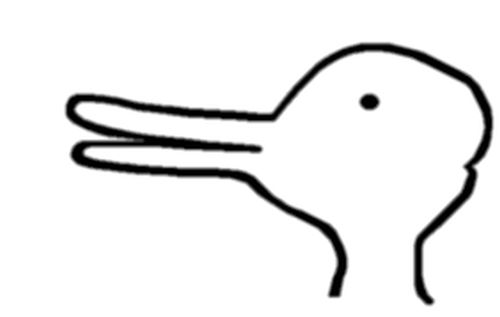
To reflect on this image - a reflection which will be useful as a tool for discussing metamodernist genius - let us go on a tangent and imagine an alternate, science-fiction world. There, you have seen the image, above, thousands of times throughout your life, as has everyone else who has ever lived. It is a popular image. But suppose no one has, in the past, ever realized that the image can be seen as a Rabbit. Suppose it has only ever been seen as a Duck. (This scenario bears some slim resemblance to one discussed by Wittgenstein, p. 194e).
We can imagine that everyone in the world has been conditioned to see the picture as a Duck. That is what everyone calls it, that is our habitual way of perceiving it, and we are accustomed to sometimes see the image surrounded by other pictures of Ducks (5). Now suppose an artist - we can imagine him bearded and shaggy, living high up in a cave - comes down from the mountains, and declares to us that this image can be seen as a Rabbit. He points out the ears and nose. Perhaps he even draws pictures of Rabbits surrounding the image, to help us out. Finally, startled and almost-alarmed, you see it as a Rabbit, instead of as a Duck! Your eyes would grow wide, and you gasp: "The picture is altogether different now!" (Wittgenstein, p. 195e).
(IS THIS POSSIBLE? HOW COULD ANYONE, BROUGHT UP IN SUCH A WORLD, EVER COME TO SEE IT AS A RABBIT? PERHAPS THIS WHOLE SCENARIO BREAKS DOWN, AND BECOMES IMPOSSIBLE. PERHAPS, FRUSTRATINGLY, THE PEOPLE OF THIS WORLD ARE EXASPERATINGLY AND UNSATISFYINGLY STUCK WITH ONLY ONE OPTION, RATHER THAN WITH A PLETHORA OF POSSIBLE OPTIONS. THIS MIGHT INDEED BE THE CASE. BUT, WITH CHOSEN NAIVETY, I REJECT IT! I REJECT IT, HERE! I YEARN FOR THE POSSIBILITY OF THE NEW - FOR A SATISFACTION THAT I HOPE IS ON THE HORIZON!)
So, you suddenly see the picture as a Rabbit, and it seems altogether different to you. And yet, you know that the image remains exactly the same. The image in front of you has not, in itself, altered. And likewise, there is a sense in which your perception, itself - what you see - has also remained unaltered. If you were, again, asked to draw what you see, reproducing the shape and lines as accurately as possible, the result would look basically-indistinguishable from your earlier effort, even though you now see the image as a Rabbit rather than as a Duck (Wittgenstein, p. 196e; also Lycan, p. 231).
Once you see it as a Rabbit, the picture is both altogether different, and yet entirely the same. Wittgenstein: "I see that it has not changed; and yet I see it differently" (p. 193e).
Nothing has, in any real sense, been unveiled to you. Nothing was ever covered. The Rabbit was always there, in plain sight. You just didn't see the image that way - as a Rabbit. What did the artist - who came down from the mountain - accomplish? He increased your possibilities (6). Before, you could only see the picture as a Duck. Now, with some training, you can flicker between two options - Rabbit, Duck, Rabbit, Duck. Previously, habit and upbringing locked you into one way of seeing. But now you can choose to expect ears, rather than a beak. You have new possibilities, about what to expect (7).
How does this hypothetical relate to the topic of metamodernist genius? Suppose that, in fact, many of our ideas, experiences, objects, and theories are much like the Duck-Rabbit. Further suppose that, as in the hypothetical described above, we have all been raised and habituated to see all of these things as we currently see them, and we are completely unaware that they could be seen in radically different ways. Suppose that reality, itself (to the extent that this metaphor makes any damned sense) is a Duck-Rabbit.
What does the metamodernist genius do, when she strives - successfully or not - to accomplish Goethe's task of seeing the world anew? What she does not do is teach us how to see. We already know how to see. Nor does she unveil anything. The Rabbit is never hidden, and nor are any of the alternative ways of approaching reality. Rather, the metamodernist genius reinvigorates and possibilitizes the world, providing new options for what you can choose to see the world as, and what you can choose to expect. When all of the rest of us see reality as a Duck, she tries rather desperately to see it as a Rabbit. It might be impossible for her, but she tries nonetheless. If nothing else, she can at least point to our limitations, and thus gesture at the possibility that reality could be seen as something other than it is.
(I'D LIKE TO THINK THAT A GENIUS CAN, IN FACT, SEE REALITY AS A RABBIT, AND CAN HELP US TO SEE IT AS A RABBIT, TOO! I'D LIKE TO NAIVELY THINK THAT SHE CAN GENUINELY POSSIBILITIZE THE WORLD. SHE CAN ACTUALLY GIVE US MORE OPTIONS - RABBIT OR DUCK - RATHER THAN JUST POINT OUT A POSSIBLITY THAT WILL FOREVER ESCAPE US! SHE CAN GENUINELY REINVIGORATE THE WORLD! I WANT TO BELIEVE THIS! I WANT TO BELIEVE THAT A GENIUS REALLY CAN MOVE BEYOND OUR HABITS AND CONVENTIONS, AND SEE THE WORLD AS SOMETHING BRAND NEW. I WANT TO BELIEVE THAT THE GENIUS COULD THEN DRAW OUR ATTENTION TO THIS NEW WORLD, TOO.)
"Look," he says, "It's not just a Duck! It's also a Rabbit!"
"Oh!" We are astonished. "Would you look at that?!"
Shia LaBeouf As Duck-Rabbit
Vermeulen and van den Akker describe one of Kjartansson's performances, titled God. In it, Kjartansson sings the same line repeatedly for half an hour: "Sorrow conquers happiness." Vermeulen and van den Akker write: "By changing the tempo, the notes, or the tone of voice slightly with each new utterance, he suggests that he is attempting to get something else out of the sentence each time he articulates it afresh . . . I realize sorrow conquers happiness, but might there be a possibility that I can find some happiness or truth in it?" (Vermeulen and van den Akker (B), pp. 7-8). Kjartansson oscillates between hope and melancholy. Even though he keeps saying - or knows that - sorrow conquers happiness, he blindly hopes that it needn't - "that the ways of the world are not necessarily as they seem, but are the opposite" (Vermeulen and van den Akker (B), p. 8).
We can imagine that Kjartansson sees the world as Duck, as sorrow conquers happiness, but nonetheless hopes that he can instead see it as Rabbit, as happiness is never conquered. He keeps repeating the phrase, in much the same way that someone keeps looking at different instances of the Duck-Rabbit, trying to see in it something new, trying to see it afresh. Maybe the sentence, "sorrow conquers happiness," is a Duck-Rabbit, too. Maybe it doesn't need to be seen as melancholy. Maybe there is happiness there, too. Maybe if I keep looking, keep repeating, keep trying different tones and notes, I'll finally see it. Maybe! He oscillates between melancholy on the one hand - Duck - and the possibility that there might be something else to find as well - Rabbit.
LaBeouf who is a/the quintessential metamodernist artist, is a bit of a Duck-Rabbit, too. He can see himself as two different things - original genius, and unoriginal genius. Seeing himself one way, he is committed to #STARTCREATING. Let's sincerely strive to see the world new. Seeing himself another way, he is committed to #STOPCREATING. Let's ironically appropriate, re-organize, and re-format the world that already exists. Presumably, we can view him as either original or as unoriginal, flickering back and forth between the two as we do when we look at the image of the Duck-Rabbit.
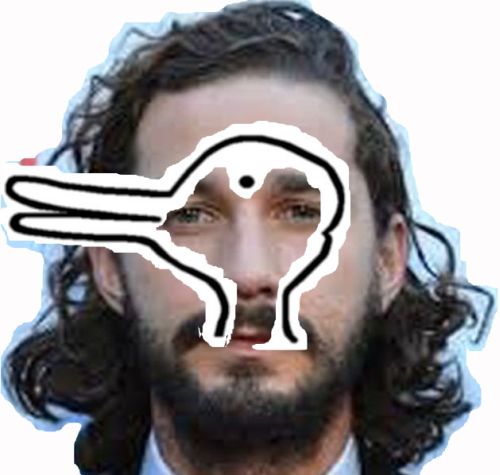
Why Be Original?
Goethe suggests that, in order to see anew the world that is right in front of us, and guide others to see it too, requires original genius with its radical spontaneity. Even the mature Goethe, who believed in the value of tradition, suggests that a person's "spontaneous creative energy" (Beddow, p . 106), which is within him/her, must be intertwined with that tradition, to move the world forward.
In order to see the world anew, it isn't enough to look closely at the external world, itself. In the final quatrain related to the painting of "Genius Unveiling a Bust of Nature," Goethe writes that a genius must "First penetrate within / Then return toward the outside, / Then you will be instructed in the best way" (8). You can only see the world anew and better if your perceptions are accurately guided by intuitive knowledge (see Hadot) - by an intuition within you, which requires you to penetrate yourself.
To see the world anew, as Goethe recommends, really does seem to be the work of original genius, rather than the work of unoriginal genius. Even the language he uses seems to compel us to see his genius this way. Remember that theorists tend to describe original genius as organic and natural, and unoriginal genius as artificial and mechanic. While Goethe does not appeal to two separate notions of genius, he does use the same sort of language. Referring to the painting of "Genius Unveiling a Bust of Nature," which you can scroll up in this project to see, Goethe instructs the figure not to focus on the bust, but rather to turn to the landscape behind him (Hadot, p. 252), writing: "If you want to live, poor fool, / Look only behind you, toward empty space." For genius to remain alive, it cannot see nature as a bust, or as a fixed and artificial figure. Rather, illuminated by intuition, you should see nature "all at once" (9) as the changing, organic landscape that it is. In a different context, Goethe suggests much the same sentiment; the true genius's process is organic rather than mechanic, and you cannot constrain nature "with levers and screws" (10).
But why couldn't Goldsmith's process - appropriating and re-arranging texts and images - just as successfully change our perceptions, and let us see the world as Rabbit rather than as Duck? Even if we can take Goethe to very-indirectly imply that a process like Goldsmith's could never be successful, why couldn't it?
I was unable to find an answer that satisfied me, until I read a passage by William Lycan, which he wrote while exploring Wittgenstein's discussion of the Duck-Rabbit: "A person who had never seen a real Rabbit, or a picture of one, could not see the Duck-Rabbit as a Rabbit, unless he were given to random, uncontrollably fantastic imaginings" (Lycan, p. 234).
Imagine, again, the world in which everyone has seen the image of the Duck-Rabbit, but we've always seen it only as a Duck, and never as a Rabbit. But further suppose that we have never actually seen any Rabbits, either. Then, the only way that the artist, in his mountain cave, could start to see the image as a Rabbit would be if "he were given to random, uncontrollably fantastic imaginings" (Lycan, p. 234).
An unoriginal genius, such as Goldsmith, could never accomplish this. All Goldsmith can do is select from thousands of pre-existing types of font, or choose between a million pre-existing paragraphs, or a hundred million photographs, to use on his cover. But as long as the unoriginal genius is making choices between pre-existing options, he will never select or create a new option. What does a genius do, when she sees the picture as a Rabbit even though everyone else has always seen it as a Duck and nobody has even ever seen an actual, breathing Rabbit? The genius must suddenly spot a brand new option, never before established. When she helps us to see the picture that way, too, she helps us to discover a brand new possibility for ourselves - a possibility that never existed before. She reinvigorates and possibilitizes the world, in a way that an unoriginal genius, who can only select from his pre-existing options, can never do.
Goldsmith's process involves looking outside himself - at other people's digital data, such as texts, worlds, and images, and recombining, omitting, juxtaposing, and reformatting them. But instead of looking outside, the original genius must "penetrate within." If the original genius is going to find a brand new, never-before-established choice for what to see the world as, he is going to have to find it in himself. The new option must be spontaneously created within him, rather than found outside him. Thus, the original genius artist, to accomplish Goethe's task, must have something special inside him - perhaps not innately, but nonetheless there - that enabled him to see in the image what no one else saw! It would, for the rest of the world and perhaps even to the artist, herself, seem like magic!
It might, in fact, be completely impossible for anyone to start seeing the world in such a radically different way - a way that, were we to see it, would help us lead better lives and move toward a more-unified, happy world. Vermeulen and van den Akker's work is full of the sense of impossibility. For example, they suggest that, while utopian desires play an important role in many metamodernist projects, the artists themselves lack conceptual tools necessary to imagine utopia, and realize that utopia could never be realized even if they didn't (Vermeulen and van den Akker (B), p. 11). They suggest, then, the metamodernist artists inevitably must make attempts "in spite of their inevitable failure" (Vermeulen and van den Akker (B), p. 12). They associate metamodernism with an "informed naivety"; its artists knows that we aren't moving forward to some ultimate goal, but commit themselves to acting as if such a goal exists and is achievable (Vermeulen and van den Akker (A), p. 5).
The metamodernist genius, then, is much like the woman who is trying desperately to see reality as Rabbit, when all she or the rest of us can see is Duck. It is impossible for her, and she knows it, but she chooses (self-enforces) to remain half-naive, and to optimistically seek the Rabbit, anyway. If nothing else, she can at least point to our limitations, and let us know our limits. According to Vermeulen and van den Akker, this is at least distantly relevant to what the artist, Thorpe, does in his work, which appropriates numerous seemingly-incompatible contexts and sensibilities. Thorpe doesn't show us a stable, achievable, imaginable utopia. Instead, he "shows us the possibilities of the future precisely by drawing attention to the intertextual limitations of the multifarious past" (Vermeulen and van den Akker (B), p. 6). We may not be able to see or achieve Rabbit, but at least we'll know we're stuck on Duck and something else is out there.
I no doubt feel this sense of impossibility myself - this sense of moving forward blindly and optimistically, with a self-enforced naivety - despite every indication that the world is going to shit. I feel the impossibility, but I REJECT IT. Here, at the end of this project, I happily reject this aspect of metamodernism. I reject it. I reject it with a heartfelt need. I naively reject it. A new way of seeing - a better way of seeing - can be achieved, and, once achieved, it can be realized in action. I choose - very, very deliberately choose - to believe this. I do not think that everyone is capable of seeing the world in a brand new way - finding the Rabbit when everyone else is stuck on Duck. I do think there are people - though not me - who are capable of doing so, who have something inside them comparable to magic.
This is not ridiculous. Despite what a Postmodern theorist might say, there exist great-souled men and women who possess an "inner richness" or "inspiration" (Jameson, p. 306), which make it possible for them to accomplish their work, and without which, no matter how well they maximize the resources available to them, and no matter how well they could assess the systems around them and act within them, they could never have succeeded. As long as they are just exploiting external systems and their possibilities, an artist will never be able to generate a truly new choice. And some artists have magic in them that enable them to make new choices, and to possibilitize the world for us! Let me - non-ridiculously - proclaim myself a member (a blind follower rather than a leader) of the cult of the great-souled man!
FIN!!!
* * *
You can visit Andrew J. Corsa's main webpage here. You can find him on twitter.com here.
* * *
(1) The choice to mention Edward Young was not arbitrary. His work had a substantial impact on the thinking of Goethe, whose account of genius I discuss later (for more about this, see Beddow).
(2) Goethe, Zahme Xenien, vol. 6, in WA, I, 3, p. 354. As translated in Hadot, Veil of Isis, 253.
(3) Goethe, Xenien, 155, HA 10:435-436 As translated in Hadot, p. 257.
(4) Goethe, Epirrhema, WA, I, 3, p. 88. As translated in Hadot, p. 256.
(5) The way I described this scenario was influenced indirectly by several of William Lycan's claims, in the context of discussing the Duck-Rabbit. The first: "Our weighting of the criteria in a given case is itself affected and conditioned to some extent by representational convention and by our own habitual way of seeing real objects" (Lycan, p. 232). The second: "Two congruent Duck-Rabbits can be 'seen as' being quite dissimilar if one is surrounded only by picture-Ducks and the other only by picture-Rabbits" (Lycan, 229).
(6) Lycan refers to the ""The range of possibilities for 'seeing as' which [an artist] has set before us" (Lycan, 230).
(7) Lycan writes that we "'cannot' see both the Rabbit and the Duck, in the sense that the mass of expectancies . . . involved in seeing the Rabbit is incompatible with the equally weighty mass involved in seeing the Duck" (Lycan, pp 231-232).
(8) Goethe, "Genius die Buste der Natur enthullend,"in WA, I, 4, p. 127. As translated in Hadot, p. 249.
(9) Goethe, "Allerdings: Dem Physiker" (Certainly: To the Physicist), in the group of poems titled Gott und Welt (God and the World), WA, I, 3, p. 105. As translated in Hadot, p. 253.
(10) Goethe, Faust pt. 1, 11, 668-674 in Theatre compet (Paris, 1958), p. 971 [in English, Goethe, Faust: A Tragedy, trans. W. Arndt, ed. C. Tamlin (New York, 1976) - Trans.] As in Hadot, p. 250.
Books and Articles from Traditional Academic Journals
Beddow, Michael. "Goethe on Genius." In Genius: The History of an Idea, edited by Penelope Murray, 98-112. Oxford: Basil Blackwell, 1989.
Goldsmith, Kenneth. Uncreative Writing: Managing Language in the Digital Age. New York: Columbia University Press, 2011.
Hadot, Pierre. The Veil of Isis: An Essay on the History of the Idea of Nature. Translated by Michael Chase. Cambridge, Mass: The Belknap Press of Harvard University Press, 2006.
Jameson, Frederic. Postmodernism, or, the Cultural Logic of Late Capitalism. Durham: Duke University Press, 1991.
Lycan, William G. "Gombrich, Wittgenstein, and the Duck-Rabbit." The Journal of Aesthetics and Art Criticism 30, no. 2 (1971): 229-237.
Perloff, Marjorie. Unoriginal Genius: Poetry by Other Means in the New Century. Chicago: The University of Chicago Press, 2010.
Vermeulen, Timotheus and van den Akker, Robin (A). "Notes on Metamodernism." Journal of Aesthetics & Culture 2, no. 10 (2010): 1-14.
Vermeulen, Timotheus and van den Akker, Robin (B). "Utopia, Sort of: A Case Study in Metamodernism," Studia Neophilologica (2014): 1-13.
Wittgenstein, Ludwig.
Young, Edward. Edward Young's Conjectures on Original Composition. Edited by Edith J. Morley. London: Longman, Green, & Co, 1918.
Web-Based Content: In Order of Reference
Schwarz, Abigail Ann. "On Shia LaBeouf's Metamodern Performance Art." Notes on Metamodernism. April 8, 2014. Accessed March 10, 2015. http://www.metamodernism.com/2014/04/08/on-shia-LaBeoufs-metamodern-performance-art/#comments
TMZ Staff. "Shia LaBeouf: Latest Skywriting Stunt Cost $25,000." TMZ. January 11, 2014. Accessed March 10, 2015. http://www.tmz.com/2014/01/11/shia-LaBeouf-skywriting-apology-retirement-25000/
Admin. "Shia LaBeouf's #IAMSORRY at Cohen Gallery." Olson Visual. March 6, 2014. Access March 10, 2015. http://olsonvisual.com/shia-LaBeoufs-at-cohen-gallery/
LaBeouf, Shia. "#stopcreating." The New Inquiry. January 20, 2014. Accessed March 10, 2015. http://thenewinquiry.com/features/stopcreating/
LaBeouf, Shia, Nastja Säde Rönkkö, and Luke Turner. "#INTERVIEW." Accessed March 10, 2015. http://thecampaignbook.com/interview/
Turner, Luke. "Metamodernism: A Brief Introduction." Notes on Metamodernism. January 12, 2015. Accessed March 16, 2015. http://www.metamodernism.com/2015/01/12/metamodernism-a-brief-introduction/
Leitch, Scott. "Shia LaBeouf Runs Metamarathon Art Project." Canadian Running Magazine. September 26, 2014. Accessed March 10, 2015. http://runningmagazine.ca/shia-LaBeouf-runs-metamarathon-art-project/
Turner, Luke "Metamodernist Manifesto." 2011. Accessed March 10, 2015. http://www.metmodernism.org
"Metamodernism - the Return of History 25 Sep 2014." The Stedelijk Museum Amsterdam. Accessed March 10, 2015. http://www.stedelijk.nl/en/calendar/symposia/Metamodernism-the-return-of-history
Vermeulen, Timotheus. "Timotheus Vermeulen on Metamodernism." By Cher Potter. May 2012. Reproduced on lonelyfingers.com. Accessed March 10, 2015. http://www.lonelyfingers.com/timotheus-vermeulen/